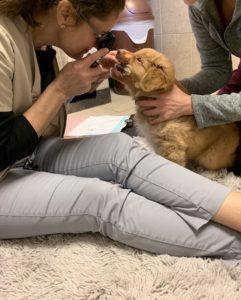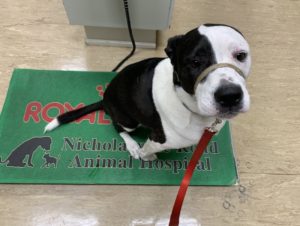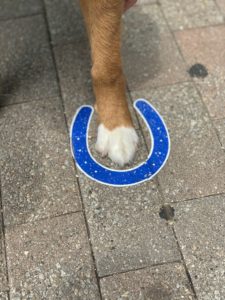by Mandy | Jan 17, 2020 | Training advice
While a dog trainer is an important part of the dog care team, there are some things trainers can’t fix. This doesn’t mean they can’t be helpful and it doesn’t mean they don’t understand. What it means is they may need the additional support of a veterinarian or veterinary behaviorist and in all cases they need 100% dedication of the owner to implement the management and training for it to be successful.
What a Trainer Can’t Fix
- Dogs that don’t like other dogs.
- It’s not possible to make dogs like each other, just like it’s not possible to make people like each. Dogs that show aggression or fear to other dogs are managed. While it may be possible to work with a dog to make them more comfortable around other dogs, it doesn’t mean they want to interact or play with other dogs.
- Your dog’s behavior.
- We can’t fix behavior when owners don’t contribute to the training as suggested. To change a dog’s behavior, owners have to change their behavior. Owners must be committed to training lessons, classes, and practice. Your trainer doesn’t live with your dog. They spend very little time with your dog. It’s up to you to learn from your trainer and implement the techniques on a day to day basis.
- Genetics.
- Before bringing a dog into your home, you should know the function of the breed or breeds of the dog. Breed club websites are a great place to learn about the characteristics of breeds. Is the dog bred to herd? Be prepared to manage the desire to chase and nip. Is the dog bred to guard? Be prepared to have a dog that doesn’t make friends quickly. Understand that mix breeds don’t mean you will get the best of both breeds. You can just as easily get the worst of both breeds. Best bet. Contact a trainer BEFORE you get a dog and let them help you choose your next best friend.
- Natural developmental stages.
- Puppies nip and bite. Adolescent dogs are 4 legged teenagers; they make poor choices and have a hard time controlling impulses. What a trainer can do is help you manage these stages.
- Aggression
Aggression is managed. It’s not cured. The sad truth is that aggression is an illness and can be terminal. While a qualified trainer may be able to help an owner successfully manage their dog, there is no guarantee that a dog won’t bite. Every dog that has a mouth and teeth has the ability to bite, some dogs use that ability more than others.  Train Don’t Complain,
Train Don’t Complain,
Mandy Eakins KPA CTP, CPDT-KA
Manners Matter Dog Training and Daycare, LLC
by Mandy | Jan 10, 2020 | Training advice
 Most veterinarians understand the importance of having a good trainer as part of their team. Working with a qualified trainer can not only keep dogs in their homes, but they can also help a family choose a new dog. Dog trainers are also a great resource to assist with recovery and healing through the use of mental enrichment while on crate rest or limited activity. We can also help ease the stress of scary vet visits that may keep owners from seeking the medical treatment their dog needs. If I had a chance to to talk with veterinarians, this is the information I would like them to know.
Most veterinarians understand the importance of having a good trainer as part of their team. Working with a qualified trainer can not only keep dogs in their homes, but they can also help a family choose a new dog. Dog trainers are also a great resource to assist with recovery and healing through the use of mental enrichment while on crate rest or limited activity. We can also help ease the stress of scary vet visits that may keep owners from seeking the medical treatment their dog needs. If I had a chance to to talk with veterinarians, this is the information I would like them to know.
What I Want Veterinarians to Know About Dog Trainers
- Trainers can help keep clients in your practice.
- It’s true. Most dogs are turned into shelters and rescues because of undesired behaviors. What happens then those dogs go to shelters or other homes? They come out of the veterinary practice. Working with a qualified trainer helps keep those dogs in their homes and in your practice. See below for how to find that qualified trainer.
- Not all trainers are the same.
- I know I sound like a broken record on this one because I say it all. the. time. But it’s so true. Take the time to interview trainers that you will be referring too. Call trainers in to do a 15 minute meet and greet and ask about their methods, and education. Do their standards and values match those of your clinic? Are they focusing on the human animal bond using the least invasive methods available? Most trainers give a discount to veterinary professionals. If you can’t take a class, go observe once or twice. Reach out to your local trainers or take the time to respond to their requests for meet and greets or lunch and learns. Good trainers want to work with the veterinary team as part of a training or behavior modification plan. The American Veterinary Society of Animal Behavior has a great online resource for “How to Choose A Trainer”
- Do you know what certifications mean? Do you know what certifications are out there? Below is a list of the most common certifications and professional organizations. You can check out my credentials here if you are interested. This is a great place to start when looking for trainers in your area as most of these organizations keep an online list of qualified trainers. While not all trainers pay to keep a listing online with the group, look for these titles on business cards, handouts, etc. Each group below has their own certification guidelines. It’s usually a quick process to read their standards and find out what testing or evaluation has been done for a trainer to hold one or more of these titles.
- Many behavioral issues are due to medical issues.
- Dr. Amy Pike, DVM, DAVCB has a great read, “Medical Causes of Behavior Problems in Dogs and Cats”. Trainers often see dogs where they are most comfortable and will exhibit symptoms that might not surface in an exam room. It’s also not uncommon for clients to share information or concerns that they wouldn’t normally bring up in a veterinary visit. Encourage the trainers you refer to to share progress or changes with you throughout their training plans. Dogs that have a history of chronic pain or pain associated with a particular incident may need the help of a qualified trainer to counter condition or desensitize that association. If you have a patient that has suffered an injury or is being treated for chronic pain, suggest a trainer to help with any behaviors that may be a result of that pain.
- Training for recovering patients and crate rest cases.
- Occasionally it’s necessary for dogs and even puppies to have to be put on limited activity and or crate rest. For puppies this can be detrimental to their mental development and socialization. For adult dogs this is incredibly boring and can create undesired behaviors such as destruction or even self mutilation. Training doesn’t have to be physical to be effective. There are many crate games, and low activity games that can both stimulate the mind while being easy on a recovering body. One of my favorite cases was an older puppy that was unfortunately hit by a car the week before class started. The puppy had a broken leg and was on crate rest. We did the entire 6 week class with the puppy in a crate. She learned all her basics in a crate and YES, the behaviors carried over outside of the crate. Her leg healed perfectly and she didn’t miss out on training during a critical time in her development.
- Hard To Treat Patient

- Every vet has a story about those nightmare patients. The ones who are extremely fearful and make even the most simple of procedures a costly and unpleasant experience for everyone involved. Dogs can be taught to accept low stress blood draws, as seen in this video, low stress nail trims as seen in this video, as well as many other common veterinary procedures like ear cleaning, eye drops and vaccines. Our training center offers a class specifically designed to teach these techniques to hopefully make stressful visits a little less so. More information about that class is available on our scheduling page. I have been thankful on more than one occasion that my dogs are comfortable with veterinary procedures. It has given me time with them that I wouldn’t have otherwise had and has made recovery from major surgeries easier.
- Prevention
- Getting dogs into socialization and training early is key. Quoted from The American Veterinary Society of Animal Behavior, “In general, puppies can start puppy socialization classes as early as 7-8 weeks of age. Puppies should receive a minimum of one set of vaccines at least 7 days prior to the first class and a first deworming. They should kept up to date on vaccines throughout the class.” While it is still commonly suggested by many veterinarians, puppies do not and should not wait until all vaccines have been given to start training.
- New dogs. Established clients that are thinking of getting another dog should be put in contact with a trainer to help with the new addition. Many trainers can even help owners make choices on finding a reputable breeder, shelter, or rescue group. Trainers can also help the owners introduce new housemates safely, giving the best chance for a successful addition to the family. Our Puppy Head Start class is open enrollment, offering class two nights a week. It is by far our most important of the classes we offer.
There are occasions when the situations are difficult and we need an outside opinion or assessment. In cases of severe anxiety, fear, or aggression, a Veterinary Behaviorist can be very helpful. While not available in all areas, most will consult with a general practice vet office for little to no charge. A veterinary behaviorist can help with medication choices and protocols. Research is happening all the time in the field of behavior and there are so many options for treatment. To find the nearest Veterinary Behaviorist, check out the American College of Veterinary Behaviorists to find the nearest one to your area.

by Mandy | Jan 3, 2020 | Uncategorized
There are a few things I wish dog owners knew. While yes, these things would make my job easier, honestly it would keep more dogs in their homes. Shelters are full of dogs that no one wants because of behavior issues. Behavior issues that could have been avoided in most cases. I came up with the following list based on my most frequent conversations with clients and potential clients.

10 things I wish people knew
- There is no regulation in the dog training world
- Did you know there are more regulations and licensing for a manicurist than a dog trainer? There are absolutely no regulations or governing bodies that oversee the profession of dog trainers. Anyone can call themselves a dog trainer and sadly they do. Just because someone has had dogs all their life doesn’t make them a trainer. That would be like saying, “I’ve had teeth my whole life. I’m qualified to be a dentist.” It sounds absurd and it is. Being a police officer, a groomer, a veterinarian, a dog lover, a shelter worker, or buying into a franchise does not qualify someone to be a dog trainer. Look for trainers that belong to a professional organization that follows a code of ethics, can show proof of continuing education, and hold a nationally recognized certification.
- All trainers and training is not the same
- A great resource for how to find a dog trainer is outlined by the American Veterinary Society of Animal Behavior. Dog training using tools like prong collars, shock collars (if it’s an electric collar it’s a shock collar), throw chains, spray bottles and other forms of physical correction are not veterinary recommended forms of training and should be questioned. Dog training is a science like any other behavior science and should be taught as such. Dog trainers should be taking into consideration the health of the dog, the behavior history of the dog, and breed of dog. Consideration for the goals, resources and comfort level of the family working with the dog should also be a part of a training program. Dog training is not a “one size fits all” industry. It’s not all about sit, down, come and “place”. Dog training is not about having a dog lay on a cot for hours and hours. Click here for more information about dominance theory in training.
- You can start training before a dog has had all of their shots
- Again, look at the veterinary guidelines. AVSAB as I sited early has a great article on early puppy socialization. You can learn more by clicking here. In a clean, controlled environment, puppy socialization classes and lessons are perfectly safe. Training for puppies can begin as early as 9 weeks of age provided the puppy is showing no signs of illness.
- People food is ok
- I can feel the stares coming through the screens. People food is fine in moderation. Let me say it again for those in the back. People food is fine in moderation. I use hot dogs, string cheese, chicken, meatballs, goldfish crackers….the list goes on and on. It’s how and when you give the food, not the kind of food. Don’t be scared to explore your training treat options. Training treats are small; think the size of your pinky fingernail or smaller. And honestly….if you sat down to a bowl of dog kibble in the morning, what has it become? People food. Again, it’s how and where you give it, not what you give.

- Clickers aren’t forever
- Clicker training is a tool. You eventually fade it out of your day to day training. The clicker is used to teach new behaviors , or strengthen behaviors in a new environment. You don’t have to walk around the house with a clicker. When I do training sessions I break out the clicker and put it away in between sessions. I verbally mark desired behavior from my dog and use one of the many rewards I have available to me to reinforce that behavior or behaviors.
- You have to reward your dog
- Speaking of rewards. You have to reward your dog. Rewards can vary and that’s one of the pieces of the training puzzle. Finding what motivates your dog to continue to work. You can expect your dog to “listen because he/she wants to please me”, or “do what I say because I said so”, when you will go to work because your boss said so and you just want to please them. No, it’s not always about food. Good trainers use a variety of rewards for the dog they are working with, but they use rewards the dogs truly finds reinforcing.
- Your dog gets to decide the reward
- Pats and praise don’t always work. Neither does food. Your dog gets to decide what they like. It might be a sniff on the ground. A run around the yard chasing a ball. Finding what your dog likes is part of the fun. Experiment with rewards and see what your dog really likes.
- Your dog doesn’t know it did something bad
- They really don’t. I promise. Dogs that look guilty or hide after they have done something are responding to your behavior and actions. They also could be anticipating a correction or punishment. Don’t believe me? I bet I can make your dog look guilty about pocket lint.
- You have to be prepared when you take your dog out
- This is my most frustrating part of teaching others. I’ll spend an hour with a client in class or a private lessons going over what we need to do to change behavior. Your dog is pulling? Where is your harness? Your dog just did an amazing offered sit. WHERE IS YOUR REWARD FOR THE DOG?? You have to be prepared when you take your dog in public. Just like parents taking their babies out to eat or to the store, they go prepared with diapers, a change of clothes, toys, bottles, etc. When you leave the house with your dog you should have the following. Poop bags, treats, harness, appropriate leash, and lastly…..a plan. You have to have a plan. What are your goals for your dog? What behaviors are you trying to avoid? What behaviors are you trying to increase? To be a good leader, you have to have a good plan.
- Good Dogs take work
- It doesn’t happen overnight. It takes work. Lots of work. To change your dog’s behavior you have to change your behavior. Creating new habits is hard. Changing old habits is even harder. This dog training thing in a team sport. We have the dog, the owner, the trainer, and the vet. We all have to work together to have a happy, healthy, enjoyable dog. To get there you have to “train. don’t complain.”

Mandy Eakins KPA CTP, CPDT-KA
 Train Don’t Complain,
Train Don’t Complain,
 Most veterinarians understand the importance of having a good trainer as part of their team. Working with a qualified trainer can not only keep dogs in their homes, but they can also help a family choose a new dog. Dog trainers are also a great resource to assist with recovery and healing through the use of mental enrichment while on crate rest or limited activity. We can also help ease the stress of scary vet visits that may keep owners from seeking the medical treatment their dog needs. If I had a chance to to talk with veterinarians, this is the information I would like them to know.
Most veterinarians understand the importance of having a good trainer as part of their team. Working with a qualified trainer can not only keep dogs in their homes, but they can also help a family choose a new dog. Dog trainers are also a great resource to assist with recovery and healing through the use of mental enrichment while on crate rest or limited activity. We can also help ease the stress of scary vet visits that may keep owners from seeking the medical treatment their dog needs. If I had a chance to to talk with veterinarians, this is the information I would like them to know.



